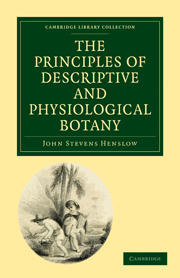Book contents
- Frontmatter
- Contents
- INTRODUCTION
- PART I DESCRIPTIVE BOTANY
- SECTION I ORGANOGRAPHY AND GLOSSOLOGY
- SECTION II TAXONOMY AND PHYTOGRAPHY
- PART II PHYSIOLOGICAL BOTANY
- CHAPTER I VITAL PROPERTIES AND STIMULANTS
- CHAPTER II FUNCTION OF NUTRITION — Periods 1, 2, 3, 4
- CHAPTER III FUNCTION OF NUTRITION — continued — Periods 5, 6
- CHAPTER IV FUNCTION OF NUTRITION — continued — Period 7
- CHAPTER V FUNCTION OF REPRODUCTION — Periods 1, 2, 3
- CHAPTER VI FUNCTION OF REPRODUCTION — continued — Periods 4, 5
- CHAPTER VII EPIRRHEOLOGY, BOTANICAL GEOGRAPHY, FOSSIL BOTANY
- INDEX AND GLOSSARY
CHAPTER IV - FUNCTION OF NUTRITION — continued — Period 7
Published online by Cambridge University Press: 05 December 2011
- Frontmatter
- Contents
- INTRODUCTION
- PART I DESCRIPTIVE BOTANY
- SECTION I ORGANOGRAPHY AND GLOSSOLOGY
- SECTION II TAXONOMY AND PHYTOGRAPHY
- PART II PHYSIOLOGICAL BOTANY
- CHAPTER I VITAL PROPERTIES AND STIMULANTS
- CHAPTER II FUNCTION OF NUTRITION — Periods 1, 2, 3, 4
- CHAPTER III FUNCTION OF NUTRITION — continued — Periods 5, 6
- CHAPTER IV FUNCTION OF NUTRITION — continued — Period 7
- CHAPTER V FUNCTION OF REPRODUCTION — Periods 1, 2, 3
- CHAPTER VI FUNCTION OF REPRODUCTION — continued — Periods 4, 5
- CHAPTER VII EPIRRHEOLOGY, BOTANICAL GEOGRAPHY, FOSSIL BOTANY
- INDEX AND GLOSSARY
Summary
SEVENTH PERIOD OF NUTRITION
(223.) Assimilation. — The chief end and object of the various processes which we have been describing, is the manufacture of the materials which are ultimately to be assimilated into the vegetable structure, and by which it is to be nourished and developed in all its parts. Of the precise manner in which the assimilation of this nutriment takes place we know nothing, and the first steps towards the formation and development of any organised being are entirely concealed from us. We may indeed observe when a gradual organisation of matter is taking place; but there is no stage in the process from whence we may not refer back to some previous state, out of which it appears to have emerged imperceptibly and inexplicably; and it is utterly impossible to note with any degree of accuracy, either the precise manner or exact time when the first traces of any new condition of organisation commenced. In other words, as soon as we can distinguish an organ it already exists in a developed form, however faintly its subordinate parts may be indicated.
(224.) Growth of the Tissues, — In dicotyledonous trees, as we have observed (art. 34. 2.), the new tissue makes its appearance between the old wood and old bark. In the earliest stage in which it is discoverable it appears as a thick clammy fluid termed the cambium, which gradually assumes the character of a newly formed cellular tissue intermixed with vessels which are disposed longitudinally through the stem.
- Type
- Chapter
- Information
- The Principles of Descriptive and Physiological Botany , pp. 227 - 248Publisher: Cambridge University PressPrint publication year: 2009First published in: 1835

